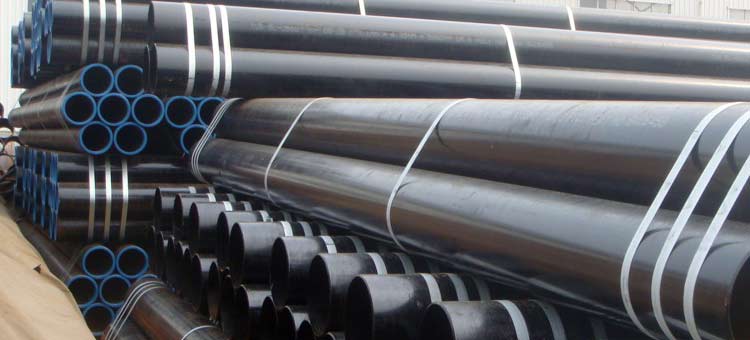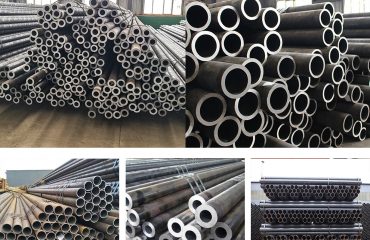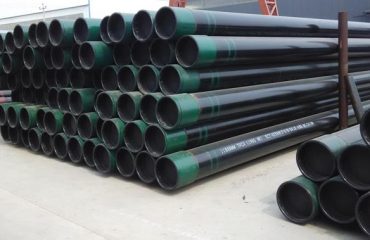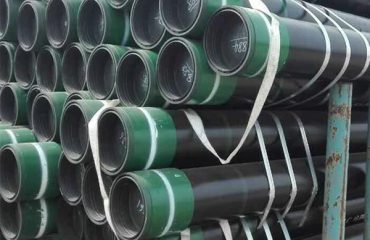
Eletrofusão ASTM A672 soldada (EFW) A Tubulação De Aço De
Introdução
ASTM A672 é uma especificação que cobre soldas por fusão elétrica (EFW) tubos de aço projetados para serviço de alta pressão em temperaturas moderadas. Esses tubos são comumente usados em indústrias como geração de energia, petroquímica, óleo e gás, e transmissão de água. A especificação fornece diretrizes para a fabricação, teste, e inspeção de tubos de aço para garantir que atendam às propriedades mecânicas e aos requisitos de desempenho necessários para aplicações de alta pressão.
O processo EFW é um método de soldagem que utiliza um arco elétrico para fundir as placas de aço., formando uma costura longitudinal. Este processo é altamente eficiente e produz tubos com excelente integridade estrutural e resistência mecânica. Os tubos ASTM A672 estão disponíveis em vários graus com base no tipo de aço utilizado e nas propriedades mecânicas exigidas.
Este artigo explorará o processo de fabricação, Propriedades mecânicas, e aplicações de tubos de aço ASTM A672 EFW, bem como os métodos de teste usados para garantir sua qualidade e desempenho.
Índice
- O que é tubo de aço ASTM A672 EFW?
- Processo de fabricação de tubo de aço ASTM A672 EFW
- soldagem por fusão elétrica (EFW) Processo
- tratamento térmico
- Graus e classes de tubo de aço ASTM A672
- Propriedades mecânicas do tubo de aço ASTM A672 EFW
- Requisitos de teste e inspeção
- ensaios não destrutivos (END)
- Teste Hidrostático
- Aplicações do tubo de aço ASTM A672 EFW
- perguntas frequentes (Perguntas frequentes)
- Conclusão
O que é tubo de aço ASTM A672 EFW? {#o que é tubo de aço astm-a672-efw}
ASTM A672 é uma especificação padrão para solda por fusão elétrica (EFW) tubos de aço projetados para serviço de alta pressão em temperaturas moderadas. Esses tubos são fabricados em vasos de pressão qualidade placas de aço soldadas por fusão usando arco elétrico. A especificação abrange tubos com costura longitudinal e destina-se ao uso em aplicações onde alta resistência e durabilidade são necessárias.
Principais características do tubo de aço ASTM A672 EFW:
-
Soldado por fusão elétrica (EFW): Os tubos são fabricados usando o processo EFW, que envolve a fusão das placas de aço usando um arco elétrico. Este processo produz uma solda longitudinal forte que pode suportar altas pressões.
-
A Embarcação De Pressão qualidade Aço: As placas de aço utilizadas na fabricação de tubos ASTM A672 são de qualidade para vasos de pressão, o que significa que eles são projetados para suportar altas pressões internas sem falhas.
-
Serviço de alta pressão: Os tubos ASTM A672 são adequados para aplicações de alta pressão, como caldeiras, Trocadores De Calor, e oleodutos na indústria de petróleo e gás.
-
Aplicações de temperatura moderada: A especificação cobre tubos projetados para uso em temperaturas moderadas, normalmente até 400°C (752° F).
-
Várias notas: Os tubos ASTM A672 estão disponíveis em diferentes graus com base no tipo de aço utilizado e nas propriedades mecânicas exigidas. As classes são determinadas pela composição química e tratamento térmico do aço.
Processo de fabricação de tubo de aço ASTM A672 EFW {#processo de fabricação de tubo de aço astm-a672-efw}
A fabricação de tubos de aço ASTM A672 EFW envolve diversas etapas, incluindo a seleção de placas de aço de qualidade para vasos de pressão, A soldagem por fusão elétrica (EFW) Processo, e tratamento térmico para alcançar as propriedades mecânicas desejadas.
soldagem por fusão elétrica (EFW) Processo {#processo efw de soldagem por fusão elétrica}
O processo EFW é um tipo de soldagem a arco que utiliza um arco elétrico para fundir as placas de aço ao longo de uma costura longitudinal. O processo envolve as seguintes etapas:
-
Preparação de Placa: As placas de aço são primeiro cortadas nas dimensões exigidas e inspecionadas quanto a quaisquer defeitos ou imperfeições superficiais.
-
Preparação de Borda: As bordas das placas de aço são chanfradas para garantir a fusão adequada durante o processo de soldagem. O ângulo de bisel é cuidadosamente controlado para obter uma solda forte.
-
soldagem por fusão elétrica: As placas são posicionadas de ponta a ponta, e um arco elétrico é usado para derreter as bordas das placas, criando uma poça de fusão. À medida que o arco se move ao longo da costura, o metal fundido solidifica, formando uma solda contínua ao longo do comprimento do tubo.
-
Inspeção de solda: A solda é inspecionada quanto a defeitos como porosidade, rachaduras, ou fusão incompleta. Teste não destrutivo (END) métodos, como testes ultrassônicos ou testes radiográficos, são frequentemente usados para garantir a qualidade da solda.
-
Dimensionamento e Modelagem: Após a soldagem, o tubo é passado por uma série de rolos para atingir o diâmetro e a redondeza desejados. O tubo também é inspecionado quanto à precisão dimensional.
tratamento térmico {#tratamento térmico}
Após o processo EFW, os tubos podem sofrer tratamento térmico para melhorar suas propriedades mecânicas e aliviar tensões residuais induzidas durante a soldagem. O tipo de tratamento térmico depende do tipo do aço e dos requisitos da aplicação. Os processos comuns de tratamento térmico incluem:
-
Normalizando: O tubo é aquecido a uma temperatura acima do seu ponto crítico e depois resfriado ao ar. Este processo refina a estrutura do grão e melhora a tenacidade do aço.
-
Têmpera e Revenimento: O tubo é aquecido a uma alta temperatura e depois resfriado rapidamente (apagado) em água ou óleo. Em seguida, é reaquecido a uma temperatura mais baixa (temperado) para melhorar sua ductilidade e tenacidade.
-
Alívio do stress: O tubo é aquecido a uma temperatura moderada e depois resfriado lentamente para aliviar as tensões residuais sem alterar significativamente as propriedades mecânicas.
Graus e classes de tubo de aço ASTM A672 {#graus e classes de tubo de aço astm-a672}
Os tubos de aço ASTM A672 estão disponíveis em vários graus e classes com base no tipo de aço utilizado e nas propriedades mecânicas exigidas. As classes são determinadas pela composição química do aço, enquanto as aulas são baseadas nos requisitos de tratamento térmico e testes.
Notas Comuns:
-
Grau B60: Esta classe é feita de aço carbono com resistência à tração mínima de 415 MPa (60,000 libras por polegada quadrada). É comumente usado para aplicações de pressão moderada.
-
Grau C65: Esta classe é feita de aço carbono-manganês com resistência à tração mínima de 450 MPa (65,000 libras por polegada quadrada). É adequado para aplicações de alta pressão.
-
Grau C70: Esta classe é feita de aço carbono-manganês com resistência à tração mínima de 485 MPa (70,000 libras por polegada quadrada). É usado em aplicações de alta pressão onde resistência e durabilidade são críticas.
aulas:
- Classe 10: Os tubos desta classe são fornecidos na condição de soldados, sem qualquer tratamento térmico.
- Classe 12: Os tubos desta classe são tratados termicamente após a soldagem para melhorar suas propriedades mecânicas e aliviar tensões residuais.
- Classe 22: Os tubos desta classe são submetidos a têmpera e revenimento para alcançar maior resistência e tenacidade.
Especificação de materiais {#especificação de material}
ASTM A672 os tubos são feitos de placas de aço de qualidade para vasos de pressão que são soldados usando o soldagem por fusão elétrica (EFW) Processo. A especificação cobre tubos em vários Notas e aulas, que são determinados pelo Composição Química do aço e do tratamento térmico aplicado após soldagem.
Principais características do tubo de aço ASTM A672 EFW:
- Soldado por fusão elétrica (EFW): Os tubos são soldados usando um arco elétrico fundir placas de aço, criando um solda longitudinal.
- Aço de qualidade para vasos de pressão: As chapas de aço utilizadas são de qualidade do vaso de pressão, garantindo que os tubos possam suportar altas pressões internas.
- Serviço de alta pressão: Os tubos ASTM A672 são projetados para aplicações de alta pressão no temperaturas moderadas.
- Notas e aulas: A especificação fornece vários Notas e aulas com base no Composição Química e tratamento térmico do aço.
Tabela de composição química {#tabela de composição química}
A composição química dos tubos de aço ASTM A672 varia dependendo do Grau do aço usado. A tabela abaixo descreve a composição química típica para classes comuns usadas em tubos ASTM A672.
| ELEMENTO | Grau B60 (%) | Grau C65 (%) | Grau C70 (%) |
|---|---|---|---|
| carbono (C) | 0.26 máx | 0.24 máx | 0.23 máx |
| manganês (MN) | 0.98 máx | 1.20 máx | 1.35 máx |
| fósforo (P) | 0.035 máx | 0.035 máx | 0.035 máx |
| enxofre (S) | 0.035 máx | 0.035 máx | 0.035 máx |
| Silício (Si) | 0.13-0.45 | 0.13-0.45 | 0.13-0.45 |
| cromo (Cr) | 0.30 máx | 0.30 máx | 0.30 máx |
| Níquel (Ni) | 0.30 máx | 0.30 máx | 0.30 máx |
| Molibdênio (Mo) | 0.12 máx | 0.12 máx | 0.12 máx |
| Cobre (Cu) | 0.40 máx | 0.40 máx | 0.40 máx |
| Vanádio (V) | 0.08 máx | 0.08 máx | 0.08 máx |
Notas:
- Conteúdo de carbono é um fator chave na determinação do força e Dureza do aço. Menor teor de carbono melhora soldabilidade e ductilidade.
- manganês melhora o Resistência à tração e temperabilidade do aço.
- fósforo e enxofre são mantidos em níveis baixos para evitar fragilidade e melhorar a resistência.
- Silício atua como um desoxidante durante o processo de produção de aço e melhora força.
Tabela de Propriedades Mecânicas {#tabela de propriedades mecânicas}
As propriedades mecânicas dos tubos de aço ASTM A672 são determinadas pela Grau e Classe do cano, bem como o tratamento térmico aplicado após soldagem. A tabela abaixo fornece as propriedades mecânicas típicas para tipos comuns de tubos ASTM A672.
| Propriedade | Grau B60 | Grau C65 | Grau C70 |
|---|---|---|---|
| Resistência à tração (MPa) | 415 min (60,000 libras por polegada quadrada) | 450 min (65,000 libras por polegada quadrada) | 485 min (70,000 libras por polegada quadrada) |
| Força de rendimento (MPa) | 240 min (35,000 libras por polegada quadrada) | 275 min (40,000 libras por polegada quadrada) | 275 min (40,000 libras por polegada quadrada) |
| Alongamento (%) | 22 min | 22 min | 22 min |
| Resistência ao Impacto (J) | Varia de acordo com a classe | Varia de acordo com a classe | Varia de acordo com a classe |
Notas:
- Resistência à tração é a tensão máxima que o material pode suportar antes de quebrar.
- Força de rendimento é a tensão na qual o material começa a se deformar plasticamente.
- Alongamento é uma medida da ductilidade do material, indicando o quanto ele pode esticar antes de quebrar.
- Resistência ao Impacto normalmente é medido usando Testes Charpy V-notch, especialmente para aplicações em ambientes de baixa temperatura.
Requisitos de teste e inspeção {#requisitos de teste e inspeção}
Para garantir a qualidade e desempenho dos tubos de aço ASTM A672 EFW, vários métodos de teste e inspeção são usados durante o processo de fabricação. Esses testes ajudam a identificar quaisquer defeitos ou inconsistências no material ou na solda que possam comprometer as propriedades mecânicas ou a integridade estrutural do tubo..
ensaios não destrutivos (END) {#testes não destrutivos-ndt}
ensaios não destrutivos (END) métodos são usados para inspecionar a costura de solda e o corpo do tubo em busca de defeitos, sem danificar o material. Os métodos comuns de END incluem:
-
Teste ultrassônico (OUT): Ondas ultrassônicas são usadas para detectar defeitos internos, como rachaduras, vazios, ou fusão incompleta na solda ou no corpo do tubo.
-
Teste Radiográfico (RT): Raios X ou raios gama são usados para criar uma imagem da solda, permitindo que os inspetores identifiquem defeitos internos, como porosidade, inclusões de escória, ou rachaduras.
-
Teste de Partículas Magnéticas (MT): Este método é usado para detectar defeitos superficiais em materiais ferromagnéticos. Um campo magnético é aplicado ao tubo, e partículas de ferro são usadas para revelar quaisquer rachaduras ou descontinuidades na superfície.
-
tingir teste de penetração (PT): Um corante é aplicado na superfície do tubo, e quaisquer rachaduras ou defeitos absorverão a tinta, tornando-os visíveis sob luz ultravioleta.
Teste Hidrostático {#teste hidrostático}
O teste hidrostático é um teste crítico usado para garantir que o tubo pode suportar a pressão interna a que será submetido em serviço. Durante este teste, o tubo está cheio de água e pressurizado a um nível superior à sua pressão operacional. O tubo é então inspecionado quanto a vazamentos ou deformações que possam indicar uma fraqueza no material ou na solda.
- pressão de teste: A pressão de teste é normalmente 1.5 vezes a pressão de projeto do tubo.
- Duração: O tubo é mantido na pressão de teste por um período especificado (geralmente 5 Para 15 minutos) para garantir que ele possa manter a pressão sem falhas.
Aplicações do tubo de aço ASTM A672 EFW {#aplicações de tubo de aço astm-a672-efw}
Os tubos de aço ASTM A672 EFW são usados em uma ampla gama de indústrias e aplicações onde o serviço de alta pressão e a integridade estrutural são críticos. Algumas aplicações comuns incluem:
-
geração de energia: Tubos ASTM A672 são usados em caldeiras, Trocadores De Calor, e tubulações de vapor em usinas de energia devido à sua capacidade de suportar altas pressões e temperaturas moderadas.
-
indústria petroquímica: Esses tubos são usados em refinarias, Fábricas de produtos químicos, e instalações petroquímicas para transporte de fluidos e gases corrosivos sob alta pressão.
-
Indústria de petróleo e gás: Os tubos ASTM A672 são usados em oleodutos e gasodutos, Plataformas offshore, e oleodutos submarinos para transportar petróleo bruto, gás natural, e outros hidrocarbonetos.
-
Transmissão de Água: Esses tubos são usados em sistemas de transmissão de água para transporte de água potável, águas residuais, e água industrial sob alta pressão.
-
Aplicações Estruturais: Os tubos ASTM A672 são usados em aplicações estruturais, como colunas, vigas, e suportes em edifícios e estruturas industriais onde são necessárias resistência e durabilidade.
perguntas frequentes (Perguntas frequentes) {#Perguntas frequentes}
1. Qual é a diferença entre tubos EFW e ERW?
EFW (Soldado por fusão elétrica) os tubos são soldados usando um arco elétrico para fundir as placas de aço, enquanto ERW (Resistência elétrica soldada) tubos são soldados usando resistência elétrica para aquecer as bordas do aço e fundi-las. Os tubos EFW são normalmente usados para aplicações de alta pressão, enquanto os tubos ERW são usados para aplicações de pressão baixa a moderada.
2. Quais são os graus comuns de tubos ASTM A672?
Os graus comuns de tubos ASTM A672 incluem o Grau B60, Grau C65, e Grau C70, que se baseiam na composição química e nas propriedades mecânicas do aço.
3. Qual é a temperatura máxima de operação para tubos ASTM A672?
Os tubos ASTM A672 são projetados para uso em temperaturas moderadas, normalmente até 400°C (752° F), dependendo do grau e classe do tubo.
4. Como é garantida a qualidade dos tubos ASTM A672?
A qualidade dos tubos ASTM A672 é garantida através de testes não destrutivos (END) métodos como testes ultrassônicos, Teste Radiográfico, e testes de partículas magnéticas, bem como testes hidrostáticos para verificar a capacidade do tubo de suportar a pressão interna.
5. Quais indústrias usam tubos de aço ASTM A672 EFW?
Os tubos de aço ASTM A672 EFW são usados em indústrias como geração de energia, petroquímica, óleo e gás, e transmissão de água devido à sua capacidade de suportar altas pressões e temperaturas moderadas.
Conclusão {#Conclusão}
Os tubos de aço ASTM A672 EFW são projetados para serviços de alta pressão em temperaturas moderadas, tornando-os ideais para uso em indústrias como geração de energia, petroquímica, óleo e gás, e transmissão de água. A soldagem por fusão elétrica (EFW) O processo garante uma solda longitudinal forte que pode suportar altas pressões internas, enquanto o uso de aço de qualidade para vasos de pressão garante que os tubos tenham as propriedades mecânicas necessárias para aplicações exigentes.
Os requisitos de teste e inspeção descritos na ASTM A672, incluindo testes não destrutivos e testes hidrostáticos, ajudam a garantir a qualidade e o desempenho dos tubos, tornando-os uma escolha confiável para aplicações estruturais e de alta pressão.




Você deve ser logado postar um comentário.